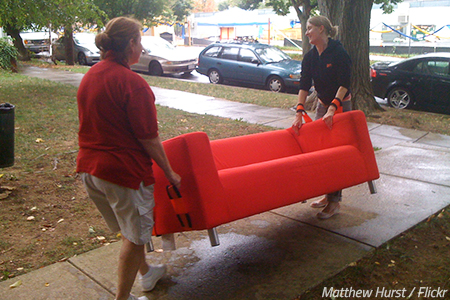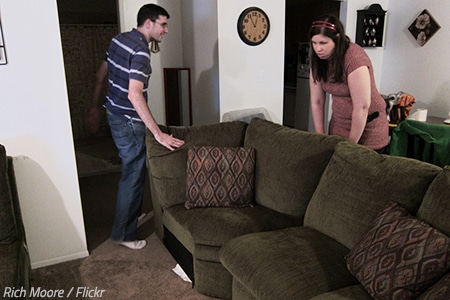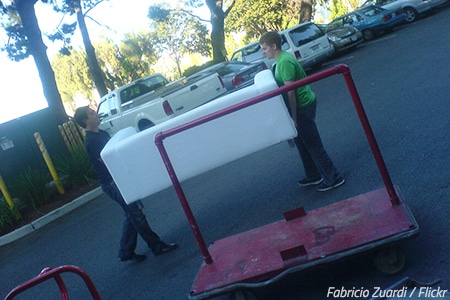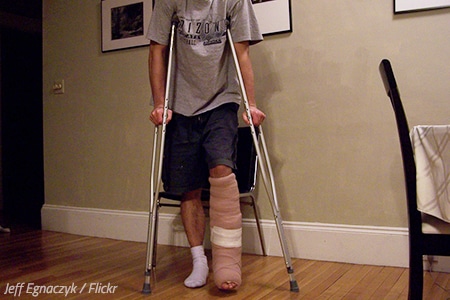 Moving heavy furniture on your own can be a very risky business, especially if you have no clear idea what it takes to achieve a satisfactory level of moving day safety. In order to avoid moving injuries or premature damage to your prized possessions when moving from one home to another, you have to be familiar with the major safety guidelines when moving furniture.
Moving heavy furniture on your own can be a very risky business, especially if you have no clear idea what it takes to achieve a satisfactory level of moving day safety. In order to avoid moving injuries or premature damage to your prized possessions when moving from one home to another, you have to be familiar with the major safety guidelines when moving furniture.
Anyone who dares to disregard the common-sense safety tips when moving furniture could end up badly hurt by taking due to handling the furniture moving job the wrong way.
The best way to move heavy furniture, which coincides with the easiest way to move furniture as well, is to let top-rated movers do it for you.
However, if professional moving assistance is just not the right way for you, then the following hand-picked safety tips for moving furniture should keep you injury-free until you reach the protection of the new home.
1. Decide if you should move your furniture at all
Moving furniture without hiring experienced professional furniture movers will always hide a number of risks and dangers for you and your helpers – from chipped walls or scratched floors, through furniture pieces damaged forever due to improper handling, all the way to possible bad personal injuries when things don’t go according to plan.
To avoid any potential complications on the day of the move, the very first thing you need to do is ask yourself if you really, really have to move the furniture items from the current place to the new home. After all, you’d make the upcoming move so much easier if you chose NOT to move any furniture at all, or took with you only a few furniture items.
When moving across the country, it rarely makes sense to haul any furniture at all because you’ll likely end up paying more money for its transportation than what it’s worth. Remember – furniture is both large and heavy, so choosing to leave behind most or all your furniture will increase the safety of your house move.
Should You Move Your Furniture or Buy New After the Move?
2. Don’t move furniture entirely on your own
One of the best safety tips when moving furniture is to never try to do it all by yourself. In other words, don’t make the rookie mistake of forming a one-man team when you’re about to lift and carry super-heavy and super-big furniture items.
The burden of moving house is too great for a single person, let alone handling overweight and oversized pieces of furniture. Remember that moving house is a team effort – it was never meant to be a solo performance. After all, moving heavy furniture alone can be plain dangerous so if you did try to be a hero on your moving day for one reason or another, the results would most likely be disastrous.
Think about what’s best for the wellbeing of your prized furniture on one hand, and what’s best for your own safety, and the safety of your family on the other hand.
If you can’t seem to afford to hire the services of furniture movers, then you must make sure you will be able to get sufficient manpower from your circle of friends. Your top priority, of course, is to ask for that invaluable friendly assistance way in advance so that you don’t disrupt unnecessarily your pals’ plans.
Once you have your friends around, coordinate your actions with the helpers so that everyone is on the same page before it’s time to lift and carry heavy pieces of furniture. Don’t forget to always take advantage of the right moving equipment and to use the proper lifting techniques to avoid injuries or property damage when you move.
Top 5 Self-Moving Mistakes to Avoid
3. Identify and eliminate all furniture moving dangers

When moving heavy furniture by yourself, make sure you have a safe exit strategy that will actually work.
Safety when moving furniture is of paramount importance – disregard the major safety moving tips and you may find yourself in a world of pain.
During the notoriously chaotic move-out and move-in days, damaging your valuable furniture – as bad as it sounds – could turn out to be the lesser of two evils. Why? Unfortunately, personal injuries of any kind are also a genuine possibility so you must do all in your power to avoid injuries when moving house.
Luckily, some safety tips for moving heavy furniture are easier to follow than others – you only need to use your common sense to make your moving experience both pain-free and trouble-free.
Here’s a very easy piece of safety advice to keep in mind when taking the furniture out of your house or apartment – just keep the exit paths and outdoor pathways clear of potential dangers. Well, this task may sound easier than it actually is.
Take a slow walk along the intended exit path of your furniture and identify any danger zones – areas, places or spots that can be dangerous when heavy items are being carried or wheeled out of the residence. Once you’ve identified the problematic areas, do your best to make them safe.
Random obstacles, packed cardboard boxes or any disorganized clutter in your home may easily jeopardize moving day safety. Keep the pathways clear at all times.
When you’re moving heavy furniture to the moving vehicle, the outside zones can also cause bad accidents so you must make sure the outdoor paths are 100% free of dust, mud, snow, and especially ice.
You can guarantee safety when moving house by creating more unobstructed space for free movement and all the accompanying unusual moves that come with Moving day.
What to Do When Furniture Will NOT Go Through the Door
4. Disassemble your furniture pieces
It’s fair to say that your large furniture pieces – king- and queen-size beds, dressers, wardrobes, cabinets, bookshelves, sectional sofas, armchairs, desks, and tables – will give you the most troubles on Moving day. In fact, furniture is regarded as one of the most difficult items to move to another home due to its oversized dimensions, considerable weight, often awkward shape, and occasional fragility and high value – antique furniture, for example.
Safety is always a big concern when moving heavy furniture by yourself, and that is exactly why the best course of action when you do decide to take some or maybe all of your large and heavy pieces with you is to hire experienced furniture movers who just know what to do.
However, in case you can’t afford professional help or you know you can take control of your house move with a few trusted friends, the next best thing is to disassemble your furniture before you take it out of your home.
It’s important to remember that furniture disassembly is one of the best safety tips for moving furniture. If you wonder why you should do it, here are just a few examples of the difficulties you may face on Moving day:
- some of your furniture pieces will be just too big to fit through standard door openings and narrow hallways unless they are broken down safely to their main components;
- some pieces will be too heavy and awkwardly shaped to be carried up or down any number of flight stairs;
- other furniture pieces you own will be too fragile to be just taken out as they are – especially if they come with breakable glass components and frail ornaments.
So, stay safe and protect your valuable possessions by disassembling your big furniture as far as it can go. Measure your furniture pieces first to see if they will fit through all door openings and hallways. If you don’t know what to do or how to do it, ask a friend who does, or even better – contact professional furniture movers.
How to Disassemble Furniture When Moving
5. Protect all furniture pieces
When moving heavy furniture, your major goals should be to
- avoid injury to yourself or to any of your non-professional helpers,
- prevent damage to the valuable furniture units, and
- steer clear of property damage to the home you’re moving out of or the home you’re moving into.
Now, one good way to help you achieve all those 3 goals at the same time is to protect the furniture pieces with soft and thick furniture blankets after you’ve disassembled them for easier handling.
By padding your furniture items, you’re ensuring that any accidental hits or bumps along the way will be absorbed by the thick layer of soft padding and no damage will reach the actual furniture surface.
- Position pieces of thick cardboard over the furniture corners or other high-risk areas to protect them against damage.
- Wrap fragile ornaments in packing paper first, then place pieces of bubble wrap over the paper layer for maximum protection.
- Use pieces of twine to secure movable furniture parts that you have not removed for one reason or another during the furniture disassembly stage.
- Cover all wooden surfaces of your furniture with padding blankets. Tape the blankets in place to keep them from unwrapping by themselves.
How to Protect Furniture When Moving
6. Use a furniture dolly to keep things safe

It’s no coincidence that the wheel is considered the most important invention ever. Is there a good reason why you shouldn’t use the wheel to make your move much easier and safer?
Don’t turn your back on the safety tips when moving house.
To prevent accidents and injury during a move, get yourself the right type of tools for moving heavy furniture as the latter has the tendency to become heavier, bigger, and trickier to transport than initially estimated.
The very first piece of moving equipment you will need to move heavy furniture safely is a moving dolly. Often regarded as a mover’s best friend, a furniture dolly is a low and flat 4-wheel platform that guarantees efficiency and safety during the furniture moving process.
It’s amazing how simple yet effective and indispensable a moving dolly can be for lifting and moving heavy objects during a move. And one thing you can be absolutely sure of is that there will be no shortage of heavy and bulky items to transport on your moving day.
Rent a sturdy furniture dolly from a local moving company or even consider purchasing one from a home improvement store. In fact, buying a furniture dolly is an investment that should pay off tenfold because even if you never have to move out of your new home, you can still use the moving dolly in the new residence for moving around and transporting all types of heavyweight stuff.
The good news is that a furniture dolly is not overly expensive. Depending on the maximum load it can support (aka load capacity), a furniture dolly can start from around $20- $40, and go up to around $50-$60 for the heavy-duty models.
7. Use furniture sliders for smooth gliding
You may need to slide a piece of furniture a short distance away from the wall or all the way across a room. And to do that safely, you will need furniture sliders.
A furniture slider is a piece of durable plastic on one side and hard rubber on the other one that will help you slide heavy furniture with ease across various surfaces with zero floor damage. Just position a slider under each leg or edge of a piece of furniture and marvel at the magic of frictionless sliding.
It’s important to note that there are two types of furniture sliders – those made for hardwood floors and those made for carpeted floors.
Now, how to move heavy furniture on hardwood floors? Get sliders that have soft, felt-like padding on one side – the side that will be gliding along the hard floor without any substantial resistance, and more importantly – without scratching the floor surface. Felt sliders are also ideal for moving furniture along tiled floors and linoleum floors as well.
How to move heavy furniture on carpet? Prepare sliders that have hard rubber or durable plastic on the side that will be gliding smoothly along the carpeted surface.
High-quality furniture sliders can be ordered online, or bought from a home improvement store or from a local moving company.
8. Use proper lifting techniques
One of the best safety tips for moving heavy objects – a piece of advice that you must use to stay protected – is to use the proper lifting techniques that are accepted as universal.
It’s important to understand that you will be forced to do tons of awkward and uncommon movements which your body has not been accustomed to – bending, pushing, pulling, twisting, and of course, lifting heavy furniture. As a consequence, you or one of your helpers could actually end up with an injury of some sort.
If you’re still not sure how to move heavy furniture by yourself, here are a number of professional moving tips to avoid injury (aka safe lifting techniques):
- Spare your back by always lifting heavy furniture with your legs. Bend at your knees, keep your back straight and use the unquestionable strength of your lower limbs.
- Whenever applicable, push heavy furniture pieces (not before having furniture sliders underneath them, of course) instead of pulling them.
- Whenever you have to turn sideways or around while holding big and heavy furniture, do so with your legs, never with your hips.
- Keep the pieces of furniture that you’re wearing as close to you as possible and in the relative center of your body.
- Some common moving injuries come as a result of wrong footing, and as you can imagine – tripping over while holding a piece of furniture will have bad consequences. Stay safe by only making slow and smooth movements, and by only making small steps as well.
- Keep your eyes focused in front of you when moving heavy furniture by yourself.
Moving safety advice: Moving day mistakes? Err another day!
9. Wear proper clothing and footwear

In hindsight, wearing flip-flops while moving heavy furniture seemed like a really bad idea.
By now you should know perfectly well that safety when moving house is your top priority.
Another safety advice for moving furniture will show you how personal injuries or property damage can really ruin your moving day from something as (seemingly) trivial as what you wear during the day of the move.
Amidst hundreds of genuine worries on Moving day, appropriate clothing and footwear can easily get overlooked. Only, you don’t want to make that rookie mistake because your conscious decision to wear proper clothes and appropriate shoes can help you achieve the level of safety you seek.
- Opt for your most comfortable change of clothes you can find in your dresser. Ideally, the moving day garments will be made of flexible and breathable material that will let you move freely.
- Don’t choose clothes you will be sorry to see dirty or even ruined – anything can happen during the most demanding day in a household move.
- Don’t wear baggy clothes as they can get hooked on a piece of furniture, which in turn could lead to accidents.
- Pick your footwear carefully. Your shoes should be of the closed-toe type, with rubber soles that provide excellent friction (anti-slip soles). Footwear with good ankle-support is preferable as well – most often, you will quickly realize that a good pair of sports shoes should be your best choice.
- Don’t forget to use high-quality work gloves that will improve your grip and protect your hands at the same time.
What to Wear When Moving: Moving Day Dress Code
10. Load the furniture with safety in mind
Safety becomes critical when you’re about to load the furniture into a moving truck without the assistance of professional movers.
The thing is that you just have to pack the furniture items in the back of the truck and secure them properly for safe transportation until you reach the new place.
- Load all the moving boxes in the truck first to create a wall of cardboard containers across the back end of the vehicle.
- Use the loading platform to get inside the truck all the furniture pieces you’re moving that have regular shapes – desks, dressers, tables, chairs, and so on. If the truck rental is equipped with a lift gate, make sure you use it for easier and safer furniture loading.
- Secure the loaded furniture items with straps or rope, tying the pieces on the hooks inside the vehicle. No furniture piece should be shifting inside during transit.
- Load any oddly-shaped furniture next, arranging it next to the pieces that have already been packed up in the moving truck and secured. Add furniture blankets around the furniture units for extra safety and whenever possible, arrange boxes to fill in any gaps that may have been created in the loading process.
- Increase safety by making sure the truck is properly balanced – that is, heavy furniture items are positioned on the opposite sides of the vehicle to maintain good balance on the road.
Must-read: Do’s and Don’ts When Moving Furniture









